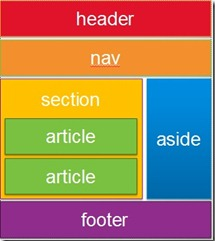HTML5 - Introduction
By: Emiley J in HTML5 Tutorials on 2013-02-17
If you haven't heard about HTML5 already then you are probably not a developer :). If you have heard about it but still wondering what the heck is this HTML5 about then this tutorial will give you a good introduction. HTML has always been neglected for more than 10 years. The last version HTML 4.x was standardized in year 1999. And after that no one really cared about HTML mainly because, CSS and JavaScripts were used to beautify and handle logics on the client side.
HTML5 is a cooperation between the World Wide Web Consortium (W3C) and the Web Hypertext Application Technology Working Group (WHATWG).
WHATWG was working with web forms and applications, and W3C was working with XHTML 2.0. In 2006, they decided to cooperate and create a new version of HTML.
Some rules for HTML5 were established:
- New features should be based on HTML, CSS, DOM, and JavaScript
- Reduce the need for external plugins (like Flash)
- Better error handling
- More markup to replace scripting
- HTML5 should be device independent
- The development process should be visible to the public\
With these objectives, HTML5 has been designed and standardized. What they did is to scan billions of webpages and learn from what the developers are already using in their current webpages. For example, <DIV> elements were widely in use to differentiate various content by using IDs and Classes in CSS. In HTML5 instead of using DIV a more meaningful semantic elements are used.
Here are a few of the new semantic elements in HTML5:
- article
- aside
- figcaption
- figure
- footer
- header
- hgroup
- mark
- nav
- section
- time
Here is a pictorial representation of how these elements can be used.

HTML5 is still a work in progress but all the major browsers including Chrome, FireFox, IE, Safari and Opera already support HTML5.
Why do you think you should learn HTML5?
The advantage of HTML5 is its support for all browsers including the mobile. Therefore you can create HTML5 based apps which will run on all mobile phones alike including iOS, Android, Windows etc which is a great relief to have one copy of your code for your applications. And in future, all existing websites will eventually be converted to support HTML5. So this is the right to learn HTML5. So get started with HTML5 now.
Add Comment
This policy contains information about your privacy. By posting, you are declaring that you understand this policy:
- Your name, rating, website address, town, country, state and comment will be publicly displayed if entered.
- Aside from the data entered into these form fields, other stored data about your comment will include:
- Your IP address (not displayed)
- The time/date of your submission (displayed)
- Your email address will not be shared. It is collected for only two reasons:
- Administrative purposes, should a need to contact you arise.
- To inform you of new comments, should you subscribe to receive notifications.
- A cookie may be set on your computer. This is used to remember your inputs. It will expire by itself.
This policy is subject to change at any time and without notice.
These terms and conditions contain rules about posting comments. By submitting a comment, you are declaring that you agree with these rules:
- Although the administrator will attempt to moderate comments, it is impossible for every comment to have been moderated at any given time.
- You acknowledge that all comments express the views and opinions of the original author and not those of the administrator.
- You agree not to post any material which is knowingly false, obscene, hateful, threatening, harassing or invasive of a person's privacy.
- The administrator has the right to edit, move or remove any comment for any reason and without notice.
Failure to comply with these rules may result in being banned from submitting further comments.
These terms and conditions are subject to change at any time and without notice.
|
Most Viewed Articles (in HTML5 ) |
Latest Articles (in HTML5) |
Comments